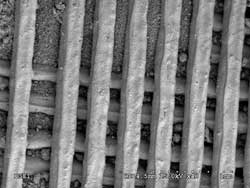Doctors at the
Bone generated from the scaffolds could be used to shore up alveolar (jaw) bone to support dental implants, as well as to repair cleft palates, fill in missing pieces of skull and repair other large and small defects.
The printer, known as a robotic deposition, or Robocaster, converts 3D information from CT scans into custom 3D printed tissue scaffolds with an unprecedented level of precision.
Because the structural elements of the scaffolds are similar in size to ingrowing bone structure (around 200µm), the bone is expected to grow faster and more accurately than bone generated from other types of tissue scaffolds.
The scaffolds are made from composites of hydroxyapatite and tricalcium phosphate that remodel with bone.
Unlike metal plates used for bone replacement, the scaffolds disappear completely from the body once the bone has regenerated, and do not require surgical removal once the bone is in place.
This is an advantage in applications such as cleft palate in children, where permanent scaffolds cannot be used because the bone must be able to change shape as the child grows.
The study is being led by Dr John Ricci, associate professor of biomaterials and biomimetics, and Elizabeth Clark, adjunct assistant professor of biomaterials and biomimetics in collaboration with Dr Jim Smay of Oklahoma State University.

A close-up view of a scaffold. The material between the struts is calcium sulphate.




Poll: Should the UK’s railways be renationalised?
Rail passenger numbers declined from 1.27 million in 1946 to 735,000 in 1994 a fall of 42% over 49 years. In 2019 the last pre-Covid year the number...